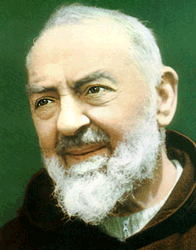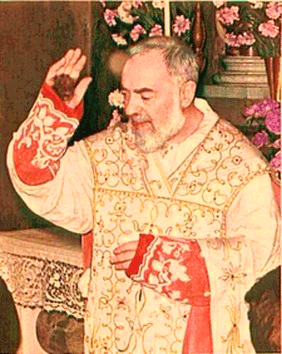Stigmatized
 On September 23, the Catholic Church remembers Francesco Forgione. Ordained a Capuchin Franciscan priest in 1910, Francesco took the religious name of Pio, and became the famed Stigmatic, Padre Pio – now St. Pio of Pietrelcina. Two persons in our living memory – Padre Pio and Mother Teresa of Calcutta – were widely acclaimed as living saints by the faithful during their lifetimes.It was an extraordinary phenomenon, and especially so given the time of social and moral upheaval in which they lived – our time. In the history of the Church, the most tumultuous eras have also produced shining examples of holiness.I share a painful anniversary date with Padre Pio. Though I always knew it, I was not really conscious of it until last year. September 23 is the day I was convicted and sent to prison. I was convicted not because of evidence – there wasn’t any – but because I am a priest. In the age of cynicism, that alone was suspect. On September 23, 1994 I was put into chains and began a prison sentence of sixty-seven years after three times declining a “plea deal” to serve only one to three years.The date of my imprisonment was entirely unknown to a man in Pittsburgh who contacted me after reading an article about me in The Wall Street Journal (Dorothy Rabinowitz, “A Priest’s Story,” April 27/28, 2005). Last year he sent me a beautiful card with a photograph of Padre Pio writing a letter. The card included the promise of a novena of Masses to commence on Padre Pio’s feast day, September 23rd, the day he entered eternal life.I began then to seek the intercession of St. Pio asking for the strengthening of my faith while in prison. The stigma of prison and its demeaning environment erodes faith and hope in too many ways to describe. It’s easy to have faith when suffering is lifted. It’s even easier when suffering is averted. Faith is a challenge when suffering is borne day after day, when it is unjust and there is no end in sight. Faith is especially difficult when suffering has a meaning and purpose known only to God. I asked Padre Pio to share my imprisonment with me, and to pray when I cannot.Padre Pio was revered as privileged to bear on his living person the wounds of Christ. I don’t imagine this always felt like a privilege. It was not just His wounds that Pio bore. He heard confessions for up to sixteen hours a day, and still the lines formed at his confessional. People waited weeks to confess their sins through Padre Pio. It had to be exhausting. He spent his entire priestly life in that one place hearing confessions day after day for 50 years – from the day of his Stigmata in 1918 until his death on September 23, 1968.
On September 23, the Catholic Church remembers Francesco Forgione. Ordained a Capuchin Franciscan priest in 1910, Francesco took the religious name of Pio, and became the famed Stigmatic, Padre Pio – now St. Pio of Pietrelcina. Two persons in our living memory – Padre Pio and Mother Teresa of Calcutta – were widely acclaimed as living saints by the faithful during their lifetimes.It was an extraordinary phenomenon, and especially so given the time of social and moral upheaval in which they lived – our time. In the history of the Church, the most tumultuous eras have also produced shining examples of holiness.I share a painful anniversary date with Padre Pio. Though I always knew it, I was not really conscious of it until last year. September 23 is the day I was convicted and sent to prison. I was convicted not because of evidence – there wasn’t any – but because I am a priest. In the age of cynicism, that alone was suspect. On September 23, 1994 I was put into chains and began a prison sentence of sixty-seven years after three times declining a “plea deal” to serve only one to three years.The date of my imprisonment was entirely unknown to a man in Pittsburgh who contacted me after reading an article about me in The Wall Street Journal (Dorothy Rabinowitz, “A Priest’s Story,” April 27/28, 2005). Last year he sent me a beautiful card with a photograph of Padre Pio writing a letter. The card included the promise of a novena of Masses to commence on Padre Pio’s feast day, September 23rd, the day he entered eternal life.I began then to seek the intercession of St. Pio asking for the strengthening of my faith while in prison. The stigma of prison and its demeaning environment erodes faith and hope in too many ways to describe. It’s easy to have faith when suffering is lifted. It’s even easier when suffering is averted. Faith is a challenge when suffering is borne day after day, when it is unjust and there is no end in sight. Faith is especially difficult when suffering has a meaning and purpose known only to God. I asked Padre Pio to share my imprisonment with me, and to pray when I cannot.Padre Pio was revered as privileged to bear on his living person the wounds of Christ. I don’t imagine this always felt like a privilege. It was not just His wounds that Pio bore. He heard confessions for up to sixteen hours a day, and still the lines formed at his confessional. People waited weeks to confess their sins through Padre Pio. It had to be exhausting. He spent his entire priestly life in that one place hearing confessions day after day for 50 years – from the day of his Stigmata in 1918 until his death on September 23, 1968. I recently read a cynical commentary by a priest who referred to Padre Pio as a “confessional machine” and “not my model of priesthood.” It was sad and shortsighted. Padre Pio was a tireless and deeply sensitive confessor. He was a conduit of grace for many – including Pope John Paul II who was deeply moved by the power and simplicity of Padre Pio in the confessional when he, as the young Karol Wotyla, was a seminarian. In the suffering Padre Pio bore in his person, and in the burden of souls and sin he carried in his heart, Padre Pio was a model of priestly witness and sacrifice.FALSE WITNESS
I recently read a cynical commentary by a priest who referred to Padre Pio as a “confessional machine” and “not my model of priesthood.” It was sad and shortsighted. Padre Pio was a tireless and deeply sensitive confessor. He was a conduit of grace for many – including Pope John Paul II who was deeply moved by the power and simplicity of Padre Pio in the confessional when he, as the young Karol Wotyla, was a seminarian. In the suffering Padre Pio bore in his person, and in the burden of souls and sin he carried in his heart, Padre Pio was a model of priestly witness and sacrifice.FALSE WITNESS
There is something else I share with Padre Pio, though it is not well known.In 1960, at the age of 73, Padre Pio was accused of sexual misconduct. The accusation came not from the unnamed women he was alleged to have abused in the confessional, but from a brother priest who brought it forward without evidence or corroboration of any kind. It was a particularly devastating accusation. Any priest so accused would be entirely unable to offer a defense due to the seal of the confessional.
If Padre Pio had been a priest in the United States, and such a claim was brought in 2002 instead of 1960, his ministry would have been terminated and he would likely have remained under a cloud of suspicion for the rest of his life. The accusation brought upon Padre Pio more than the wounds of Christ that he bore in his body. It inflicted upon him the humiliation of Christ accused of blasphemy.
Trying to tear down the Body of Christ from within is nothing new. Persecution has always been here. It just takes different forms in different ages.
Padre Pio became the subject of twelve investigations commissioned by the Holy See. The claims of sexual misconduct were dismissed as the rantings of a priest driven by envy over Padre Pio’s unsought fame and personal holiness. The priest who brought the unfortunate claims recanted them, though that part of the story is omitted from the modern, agenda-driven pundits who point to the story. On his deathbed, the accusing priest implored Padre Pio to intercede for God’s forgiveness for his false witness.St. Pio of Pietrelcina was canonized by Pope John Paul II on June 16, 2002, the very time that the Catholic sex abuse crisis in the United States had reached its media and litigation frenzy. St. Pio’s tomb is today the most visited Catholic shrine in Europe – a place of extraordinary holiness for those seeking signs of redemption in an age of confusion.THE VISITThe labyrinthine ways of grace are far beyond my understanding. Last month on August 11, I was visited in prison by Pierre, a wonderful man visiting from Europe. We had never met before, but have corresponded for four years. At our visit, there was between us a mutual sense that we had known each other for many, many years.Pierre told me that as a youth growing up in Europe, his father enrolled him in a boarding school. When he wrote to his father about a planned visit to central Italy, his father instructed him to visit San Giovanni Rotondo and ask for Padre Pio’s blessing. Pierre, a teenager at the time, went as instructed to San Giovanni and waited for hours. Padre Pio was nowhere to be seen.Pierre then approached a friar and asked if he could meet Padre Pio. “Impossible!” he was told. Just then, he looked up and saw the famous Stigmatic walking down the stairs toward him. Padre Pio’s hands were bandaged and he wore gloves. The friar, following the young man’s gaze, whispered in Italian, “Do not touch his hands.” Pierre trembled as he approached Padre Pio who placed his bandaged hand upon Pierre’s head and whispered his blessing. Sixty years later, in the visiting room of the New Hampshire State Prison, Pierre bowed his head and asked for my blessing. It was one of the most humbling experiences of my life. I placed my hand upon Pierre knowing that the spiritual imprint of Padre Pio’s blessing was still in and upon this man, and I was overwhelmed to share in it.
Sixty years later, in the visiting room of the New Hampshire State Prison, Pierre bowed his head and asked for my blessing. It was one of the most humbling experiences of my life. I placed my hand upon Pierre knowing that the spiritual imprint of Padre Pio’s blessing was still in and upon this man, and I was overwhelmed to share in it.
“Prayer is the best weapon we have; it is the key to God’s heart. You must speak to Jesus not only with your lips but with your heart. In fact on certain occasions you should speak to Him only with your heart.” St. Pio of Pietrelcina.
